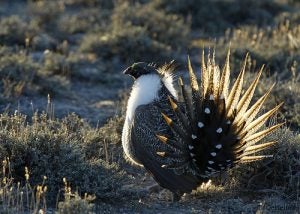A bird has united thousands. It will not divide us.

It was a sunny, cool morning – a typical September day in Colorado. I pulled up to the Rocky Mountain Arsenal National Wildlife Refuge and walked towards a stage where the state flags for Colorado, Nevada, Montana and Wyoming waved in the wind alongside the American flag.
It was a good morning. Then-Secretary of the Interior Department, Sally Jewell, had announced earlier that morning that the greater sage-grouse – a bird with habitat spanning parts of 11 western states – was “not warranted” for listing under the Endangered Species Act, thanks to one of the largest collaborative conservation efforts in America’s history.
A success story in the sagebrush sea
Sixteen million sage-grouse once roamed the American West. The Plain Indian tribes lived among the birds, hunting them for food and mimicking the males in their ceremonial dances. Meriwether Lewis spotted them “in great abundance” in 1805 during his expedition with William Clark, providing the first written account of the species.
As of 2010, there were approximately 200,000 to 500,000 birds remaining.
The roughly 90 percent population decline was the result of habitat degradation and fragmentation caused by multiple factors including increased energy and other development. Such a sharp decline for an indicator species of the broader sagebrush ecosystem was worrying. If nothing was done to save the sagebrush sea, we’d lose more than the sage-grouse.
“If nothing was done to save the sagebrush sea, we’d lose more than the sage-grouse.”
For many years leading up to the 2015 listing decision, ranchers, conservationists, industry groups, and state and federal wildlife agencies worked together to create a multi-state science-based plan to recover the greater sage-grouse. The plan worked, and the sage-grouse would not be headed to the Endangered Species List. As long as commitments to the multi-state plan remained strong, the bird would remain off the list, and landowners and industries could rest assured there would be no additional restrictions that come with a listing.
Republican and Democratic governors, ranchers and biologists, industry groups and state wildlife agencies all came together to celebrate a truly bipartisan, collaborative effort. It was a day I’ll never forget.
But the story isn’t over, yet
“Reopening the federal sage-grouse plans is a clear continuation of President Trump and Secretary Zinke’s push for energy dominance above all else.”
The administration recently re-opened the federal sage-grouse plans, creating the possibility for significant changes that could undercut the sound science used to develop those plans and jeopardize what we know the bird needs to live and thrive. Ignoring the science in favor of unproven sage-grouse recovery methods like captive breeding and population targets only increases the likelihood of a listing in the future – an outcome nobody wants.
Reopening the federal sage-grouse plans is a clear continuation of President Trump and Secretary Zinke’s push for energy dominance above all else. In this case, it comes at the expense of the West’s treasured landscapes and iconic wildlife, not to mention the thousands of people who forged the plans over many years.

We can’t allow the administration to put politics over science. We can’t allow decades of proactive, transparent and cooperative conservation efforts to be undone. We can’t set the precedent that collaborative planning and effective implementation of bedrock environmental laws like the Endangered Species Act can be undermined by administrative actions.
We the people must demand that the sage-grouse success story not be rewritten, but rather preserved and held as a model for future conservation efforts.
Related:
Dear Congress, protect the integrity of the ESA >>
Ranchers and conservationists step up to avert listing of sage-grouse >>












